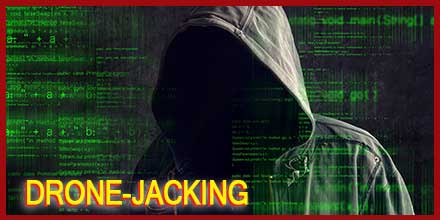Drone-jacking: a growing risk
 In a world increasingly reliant on technology to function, cyber security has quickly become an important issue.
In a world increasingly reliant on technology to function, cyber security has quickly become an important issue.
Which begs the question, how safe is your drone from a hacker attack?
Experts predict that the hijacking of drones may be one of the next big cyber threats; which raises the potential for worrying possibilities.
In its 2017 Threats Predictions Report, McAfee Labs listed drone hijackings as one of 14 cyber security issues for the coming year. The report noted that attacks against hardware – such as mobile devices and drones – would increase in 2017.
What is Drone-jacking?
Drone-jacking is the act of taking control of a drone by hacking into its operating system. While some hackers do this for fun, the biggest threats come from individuals with malicious intent.
Hacks of major sites demonstrate that the devices we now rely on are at risk. With their popularity and consumer success, drones have become a part of that conversation.
One of the growing concerns? Many consumer drones lack adequate protection against hacking. And, unfortunately, even responsible drone operators are at risk.
From recreational users to emergency responders and industrial uses, drones are becoming an integral part of life. Major tech companies such as Amazon, UPS and Domino’s are actively testing drones for use in the delivery of goods. As the number of drones in operation increase, experts fear drone-jacking may be a common occurrence.
Drone-jacking: a growing risk
The risks associated with drone-jacking are varied. Such dangers range from the potential loss of expensive drones and equipment to the destruction of private property.
For instance, reports of near misses with commercial airplanes could turn from problematic to catastrophic should the drone fall into the wrong hands. Also, military drones could be diverted from their official task and used as lethal missiles by criminal hackers.
In addition to the serious security risks stemming from drone-jacking, commercial operators also stand to lose out. Delivery drones could also be at risk of getting hijacked. Thus, robbing the company and inconveniencing customers, at the very least.
Likewise, most drones still cost a significant amount of money and come equipped with expensive equipment and accessories. So, replacing a drone in the event of a jacking comes at financial cost to the owner.
Protecting UAVs from getting drone-jacked
Thankfully, for every hacker with ill-intentions there are many more fighting for the good use of technology. Many security firms are currently working on strengthening UAV systems.
However, even as more effective defense measures are conceived, attackers continue to develop counter measures.
It is more and more imperative that Drone owners, particularly commercial operators, become vigilant about their hardware’s security. Simple steps include: staying informed, investing in the latest security and keeping software updated.
Other measures include improving the protection of data and software systems related to the UAV as well as detection capabilities and response.
Measures also include protecting the ground controller; if it is a tablet or smartphone using anti-virus software. Pilots may wish to consider using a VPN service to protect the devices’ internet connection from hackers, as well. Other users recommend varying your flight paths to reduce the chances of your UAV becoming an easy target for hackers looking to intercept it.
As a whole, the industry needs to continually develop solutions that make attacks more difficult and expensive for perpetrators to carry out.
Protecting your drone
In conclusion, both drone enthusiasts and commercial operators need to invest in security as well as robust equipment and technology. Drone-jackings may be the wave of the future but drone owners have steps they can take to protect themselves and their equipment.

